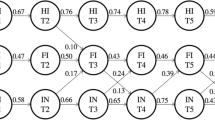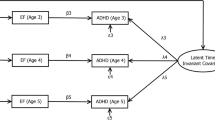Abstract
Although previous research has identified contemporaneous associations between cognitive deficits and symptom phenotypes in Attention Deficit/Hyperactivity Disorder, no studies have as yet attempted to identify direction of effect. The present study used cross-lagged path modeling to examine competing hypotheses about longitudinal associations between rapid naming speed and symptoms of inattention in children. 1,506 school-age twins from Australia and the U.S. were tested for inattention, hyperactivity/impulsivity, and rapid naming speed at three and four time points, respectively. Symptom severity of inattention from Kindergarten to fourth grade is consistently predicted by previous rapid naming, over and above auto-regressive and correlational associations in the model. Likewise, inattention symptoms have a small but significant predictive effect on subsequent rapid naming. The findings support a reciprocal relationship between naming speed and ADHD inattentive symptoms.



Similar content being viewed by others
References
American Psychiatric Association. (2000). Diagnostic and statistical manual of mental disorders (Fourth Edition-TR ed.). Washington, D.C.: American Psychiatric Association.
Arnett, A. B., Pennington, B. F., Friend, A., Willcutt, E. G., Byrne, B., Samuelsson, S., & Olson, R. K. (2011). The SWAN captures variance at both the negative and positive ends of the ADHD symptom dimension. Journal of Attention Disorders. doi:10.1177/1087054711427399.
Barkley, R. (1997). Behavioral inhibition, sustained attention, and executive functions: Constructing a unifying theory of ADHD. Psychological Bulletin, 121(1), 65.
Barkley, R., & Murphy, K. (1998). Attention deficit hyperactivity disorder: A clinical workbook (Secondth ed.). New York: Guilford Press.
Berlin, L., Bohlin, G., & Rydell, A. (2003). Relations between inhibition, executive functioning, and ADHD symptoms: A longitudinal study from age 5 to 8 1/2 years. Child Neuropsychology, 9(4), 255.
Bidwell, L. C., Willcutt, E., DeFries, J. C., & Pennington, B. F. (2007a). Testing for neuropsychological endophenotypes in siblings discordant for attention-deficit/hyperactivity disorder. Biological Psychiatry, 62(9), 991.
Bidwell, L. C., Willcutt, E. G., DeFries, J. C., & Pennington, B. F. (2007b). Testing for neuropsychological endophenotypes in siblings discordant for attention-deficit/hyperactivity disorder. Biological Psychiatry, 62, 991–998.
Brocki, K. (2006). Developmental change in the relation between executive functions and symptoms of ADHD and co-occurring behaviour problems. Infant and Child Development, 15(1), 19.
Brocki, K., Nyberg, L., Thorell, L. B., & Bohlin, G. (2007). Early concurrent and longitudinal symptoms of ADHD and ODD: Relations to different types of inhibitory control and working memory. Journal of Child Psychology and Psychiatry, 48(10), 1033.
Byrne, B. B., Delaland, C., Fielding-Barnsley, R., Quain, P., Samuelsson, S., Hoien, T., & Olson, R. K. (2002). Longitudinal twin study of early reading development in three countries: Preliminary results. Annals of Dyslexia, 52(1), 47–73.
Carte, E. T., Nigg, J. T., & Hinshaw, S. P. (1996). Neuropsychological functioning, motor speed, and language processing in boys with and without ADHD. Journal of Abnormal Child Psychology, 24(4), 481–498.
Castellanos, F. X., & Tannock, R. (2002). Neuroscience of attention-deficit/hyperactivity disorder: The search for endophenotypes. Nature Reviews Neuroscience, 3(8), 617.
Chhabildas, N. N., Pennington, B. F., & Willcutt, E. G. (2001). A comparison of the neuropsychological profiles of the DSM-IV subtypes of ADHD. Journal of Abnormal Child Psychology, 29(6), 529–540.
Hartman, C., Rhee, S., Willcutt, E. G., & Pennington, B. F. (2007). Modeling rater disagreement for ADHD: Are parents or teachers biased? Journal of Abnormal Child Psychology, 35(4), 536–542.
Hays, R. D., Marshall, G. N., Wang, E. Y. I., & Sherbourne, C. D. (1994). Four-year cross-lagged associations between physical and mental health in the medical outcomes study. Journal of Consulting and Clinical Psychology, 62(3), 441–449.
Hinshaw, S. P., Owens, E. B., Sami, N., & Fargeon, S. (2006). Prospective follow-up of girls with attention-Deficit/Hyperactivity disorder into adolescence: Evidence for continuing cross-domain impairment. Journal of Consulting and Clinical Psychology, 74(3), 489–499.
Kalff, A. C., De Sonneville, L. M. J., Hurks, P. P. M., Hendriksen, J. G. M., Kroes, M., Feron, F. J. M., & Jolles, J. (2005). Speed, speed variability, and accuracy of information processing in 5 to 6-year-old children at risk of ADHD. Journal of the International Neuropsychological Society, 11, 173–183.
Kline, R. B. (2005). Principles and practice of structural equation modeling (Second (Editionth ed.). New York: Guilford Press.
Lahey, B. B., & Willcutt, E. (2010). Predictive validity of a continuous alternative to nominal subtypes of attention-deficit hyperactivity disorder in DSM-IV. Journal of Clinical Child and Adolescent Psychology, 39(6), 761–775.
Lahey, B. B., Pelham, W. E., Stein, M. A., Loney, J., Trapani, C., Nugent, K., & Baumann, B. (1998). Validity of DSM-IV attention-deficit/hyperactivity disorder for younger children. Journal of the American Academy of Child and Adolescent Psychiatry, 37(7), 695.
Lahey, B. B., Pelham, W. E., Loney, J., Kipp, H., Erhardt, A., Lee, S. S., & Massetti, G. (2004). Three-year predictive validity of DSM-IV attention deficit hyperactivity disorder in children diagnosed at 4–6 years of age. The American Journal of Psychiatry, 161, 2014–2020.
Lahey, B. B., Pelham, W. E., Loney, J., Lee, S. S., & Willcutt, E. (2005). Instability of the DSM-IV subtypes of ADHD from preschool through elementary school. Archives of General Psychiatry, 62(8), 896–902.
Larsson, H., Lichtenstein, P., & Larsson, J. O. (2006). Genetic contributions to the development of ADHD subtypes from childhood to adolescence. Journal of the American Academy of Child and Adolescent Psychiatry, 45(8), 973.
MacCallum, R. C., Browne, M. W., & Sugawara, H. M. (1996). Power analysis and determination of sample size for covariance structure modeling. Psychological Methods, 1(2), 130–149.
McGrath, L., Shanahan, M., Santerre-Lemmon, L., Barnard, H., Willcutt, E., Olson, R., Pennington, B. (2011). A multiple deficit model of reading disability and attention-deficit/hyperactivity disorder: Searching for a shared cognitive deficit. Journal of Child Psychology and Psychiatry, 557.
Muthén, B. K., & Muthén, B. O. (1998–2010). Mplus user's guide (Sixth Edition ed.). Los Angeles, CA: Muthén & Muthén.
Nigg, J. T. (2005). Attention, task difficulty, and ADHD. British Journal of Developmental Psychology, 23(4), 513.
Nigg, J. T., Blaskey, L. G., Huang-Pollock, C. L., & Rappley, M. D. (2002). Neuropsychological executive functions and DSM-IV ADHD subtypes. Journal of the American Academy of Child and Adolescent Psychiatry, 41(1). doi:10.1097/00004583-200201000-00012.
Pennington, B. F. (2002). The development of psychopathology: Nature and nurture. New York: Guilford Press.
Plomin, R., DeFries, J. C., McClearn, G. E., & Rutter, M. (1997). Behavioral genetics. New York: Freeman.
Samuelsson, S., Byrne, B., Quain, P., Wadsworth, S., Corley, R., DeFries, J. C., & Olson, R. (2005). Environmental and genetic influences on prereading skills in australia, scandinavia, and the united states. Journal of Educational Psychology, 97(4), 705–722.
Satcher, D. (2000). Mental health: A report of the surgeon General—executive summary. Professional Psychology: Research and Practice, 31, 5–13.
Satorra, A. (2000). Scaled and adjusted restricted tests in multi-sample analysis of moment structures. In R. D. H. Heijmans, D. S. G. Pollock, & A. Satorra (Eds.), Innovations in multivariate statistical analysis. A festschrift for heinz neudecker (pp. 233–247). London: Kluwer Academic Publishers.
Shanahan, M., Pennington, B. F., Yerys, B. E., Scott, A., Boada, R., Willcutt, E. G., & DeFries, J. C. (2006). Processing speed deficits in attention Deficit/Hyperactivity disorder and reading disability. Journal of Abnormal Child Psychology, 34, 585–602.
Sonuga-Barke, E. J. (2005). Causal models of attention-Deficit/Hyperactivity disorder: From common simple deficits to multiple developmental pathway. Biological Psychiatry, 57(11), 1231.
Swanson, J., Shuck, S., Mann, M., Carlson, C., Hartman, K., Sergeant, J., & McCleary, R. (2006). Categorical and dimensional definitions and evaluations of symptoms of ADHD: The SNAP and SWAN rating scales. Irvine. Irvine: University of California.
Tannock, R. R., Martinussen, R., & Frijters, J. (2000). Naming speed performance and stimulant effects indicate effortful, semantic processing deficits in attention-deficit/hyperactivity disorder. Journal of Abnormal Child Psychology, 28(3), 237–252.
Torgesen, J., Wagner, R., & Rashotte, C. (1999). A test of word reading efficiency (TOWRE). Austin: PRO-ED.
Vukovic, R. K., & Siegel, L. S. (2006). The double-deficit hypothesis: A comprehensive analysis of the evidence. Journal of Learning Disabilities, 39, 25–47.
Wagner, R. K., Torgesen, J. K., & Rashotte, C. A. (1999). The comprehensive test of phonological processes (CTOPP). Austin: PRO-ED.
Wåhlstedt, C., Thorell, L. B., & Bohlin, G. (2008). ADHD symptoms and executive function impairment: Early predictors of later behavioral problems. Developmental Neuropsychology, 33(2), 160.
Weiler, M. D., Bernstein, J. H., Bellinger, D. C., & Waber, D. P. (2000). Processing speed in children with attention Deficit/Hyperactivity disorder, inattentive type. Child Neuropsychology, 6(3), 218–234.
Willcutt, E. G., Pennington, B. F., Olson, R. K., Chhabildas, N., & Hulslander, J. (2005). Neuropsychological analyses of comorbidity between reading disability and attention deficit hyperactivity disorder: In search of the common deficit. Developmental Neuropsychology, 27(1), 35–78.
Willcutt, E. G., Betjemann, R. S., Wadsworth, S. J., Samuelsson, S., Corley, R., DeFries, J. C., & Olson, R. K. (2007). Preschool twin study of the relation between attention-deficit/hyperactivity disorder and prereading skills. Reading and Writing, 20, 103–125.
Willcutt, E. G., Nigg, J. T., Pennington, B. F., Solanto, M. V., Rohde, L. A., Loo, S., Lahey, B. B. (2012). Validity of DSM-IV attention-deficit/hyperactivity disorder symptom dimensions and subtypes. Unpublished manuscript.
Author information
Authors and Affiliations
Corresponding author
Additional information
This research is being conducted with the support of The Research Council of Norway (154715/330), The Swedish Research Council (345-2002-3701), University of Stavanger, Australian Research Council (A79906201, DP0770805, and DP0663498), and National Institutes of Health (2 P50 HD27802 and 1 R01 HD38526). We are grateful to the many twins, their families, and the twins’ teachers for their participation and to the Colorado and Australian Twin Registries for their assistance. The Australian Twin Registry is supported by an Enabling Grant from the National Health & Medical Research Council administered by The University of Melbourne.
Rights and permissions
About this article
Cite this article
Arnett, A.B., Pennington, B.F., Willcutt, E. et al. A Cross-Lagged Model of the Development of ADHD Inattention Symptoms and Rapid Naming Speed. J Abnorm Child Psychol 40, 1313–1326 (2012). https://doi.org/10.1007/s10802-012-9644-5
Published:
Issue Date:
DOI: https://doi.org/10.1007/s10802-012-9644-5




